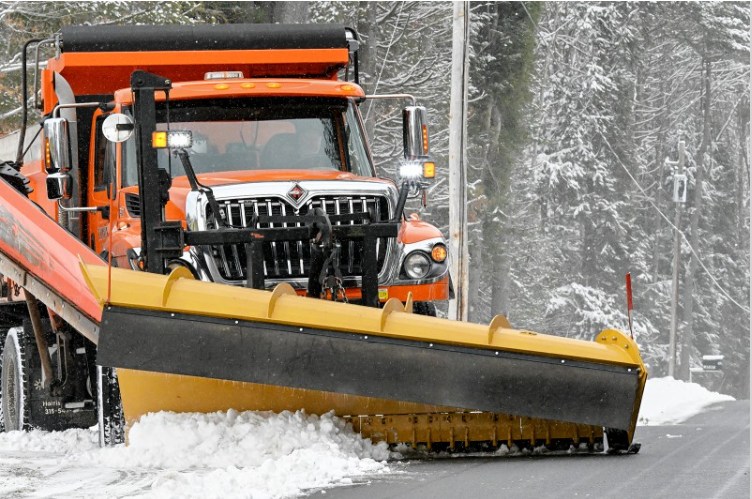Photo: Town of Edinburg MEO Rodney Finch, of Edinburg, uses the live edge plow recently purchased in their office driveway for demonstration in Edinburg on Tuesday, January 31, 2023.
GLOVERSVILLE LEADER HERALD, February 10, 2023
By Shenandoah Briere, Photo by Erica Miller
EDINBURG– As town snow-plow driver Matthew Ginter Jr. pulled out of the Edinburg Highway Department garage on a brisk January morning, he turned on the brine dispenser and a mixture of 23% road salt and 77% water began spraying on the road.
The transition to a reduced-salt brine is a major shift away from the 100 percent road salt treatments that most highway crews used for decades.ead More
The less concentrated road salt mixture enables the highway department to treat the roads down to 18 degrees road temperature and prevents the snow from sticking and freezing to the blacktop.
Combine that with the use of the latest “floating” plow blades, which are individual blades that move three inches up and down to meet the grooves of the road and the department said it’s discovered a way to keep the roads clear, save on salt costs, all the while protecting the environment, including the nearby Great Sacandaga Lake.
“Salt water will eventually get in ditches, then creeks and your creeks go to the lake,” said Wayne Seelow. “Sooner or later it’s going to get to the lake if it ain’t already there.”
It’s an issue that the Lake George area is all too familiar with and has been trying to fight.
Road salt impacts
Lake George Waterkeeper Chris Navitsky said the problems caused by road salt that have been studied in regard to Lake George can be applied to any fresh-water body – such as the Sacandaga.
It’s also an issue the U.S. Environmental Protection Agency touched on in an article posted on its website in November 2020.
“The many benefits that road salting provides, however, are matched by some opportunities for improvement,” states the EPA article. “Road salt can contaminate drinking water, kill or endanger wildlife, increase soil erosion, and damage private and public property. Alternative methods are needed to mitigate these drawbacks.”
Road salt, also known as sodium chloride, is soluble and can easily get into water. Look at the creeks and other tributaries that surround Lake George, Navitsky said. While the lake itself doesn’t have high levels of chloride, the streams around it do.
High levels of chloride are toxic, Navitsky said.
Navitsky also said chloride can increase the density of water bodies, making it difficult for them to naturally turn over twice a year–in the spring and fall– which “recirculates the oxygen through the water, which is good for fisheries.”
“Salt water goes right to the bottom,” Seelow said. “It will never leave. I don’t care what they tell you–this lake might change its water twice a year, it ain’t going to get the salt out and salt is very deadly to fish.”
Navitsky said the high levels of chloride can also lead to algae growth.
If the growth becomes too much of a nuisance or if harmful algae grows, it has the potential to prevent recreational usage of areas in bodies of water–or impede usage entirely.
But it’s not just water that can be impacted in our area, as the EPA and Navitsky indicate.
Navitsky said if you drive along the Northway, for example, the brown burn you notice on pine trees along the side of the highway is caused by road salt.
“It literally burns the trees and impacts their needles,” he said.
On top of that, the road salt seeps into groundwater and soil, killing necessary bacteria.
These effects are why the town of Hague, town of Lake George and Warren County are all implementing measures to cut back on salt. In Hague, they’re willing to teach anyone who’s interested in learning about using the salt brine mix.
That’s how Edinburg came into what town officials call one great big science project.
Savings
“It’s been remarkable for what we’ve done and so we just started spreading the word and helping other towns and other small municipalities and they’re starting to see the results,” said Tim Fiallo, a Hague Highway Department employee who helps oversee winter management operations.
They received funding from the Lake George Association and were introduced to Phil Sexton of WIT Advisors, a sustainability advisory firm.
Because of their changes over the years, Hague went from using around 1,900 tons of salt a year down to 550 tons. In Edinburg they’ve gotten down to around 460 tons of salt in 2022 after many years of typically using over 1,000 tons per year depending on the winter.
But it’s a technique that takes time to learn, Fiallo said.
Ginter Jr. said a lot of people have said they’ve tried the brine and it doesn’t work or they think it won’t work because the water will freeze on the road.
Seelow said you have to be willing to learn how it all works.
It’s a switch that can have large dividends too— and not just for the environment.
Fiallo said they used to spend around $117,000 on salt a year. Now that they’ve reduced the amount they use, they generally see savings of around $68,000 in their budgets, which they just keep reinvesting into new equipment and new techniques.
It’s the same in Edinburg.
Seelow said they’ve been able to update all their plow heads to live-edge ones to the tune of over $16,000 a piece. They’ve bought all their brine equipment too with their savings—almost $29,000 for the brine machine and $3,000 to $3,500 a piece for the brine tanks.
Seelow said he just keeps reinvesting whatever money they save in their budget.
Now they’re looking at getting a better computerized monitoring system to better track how much brine they’re putting down and looking into adding molasses to the mixture, which Seelow said would allow them to put the brine on the road up until the road temperature reaches 5 degrees.
The goal is to get more people on board now, Fiallo said.
“At first we rejected it and we hemmed and hawed over it, but we started seeing it work,” he said. “The results are impeccable. They speak for themselves.”


Recent Comments